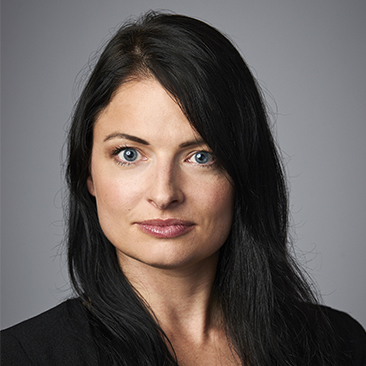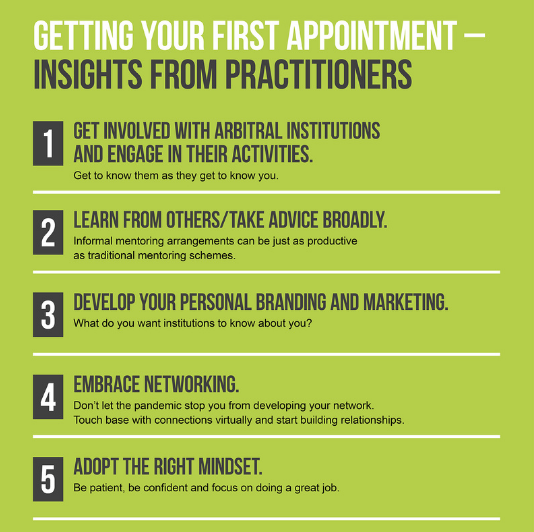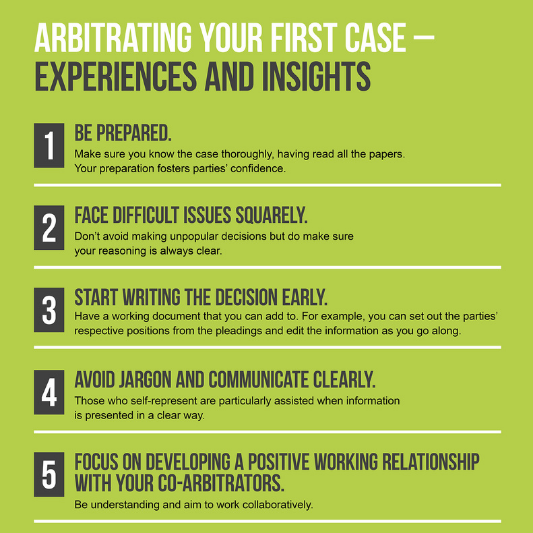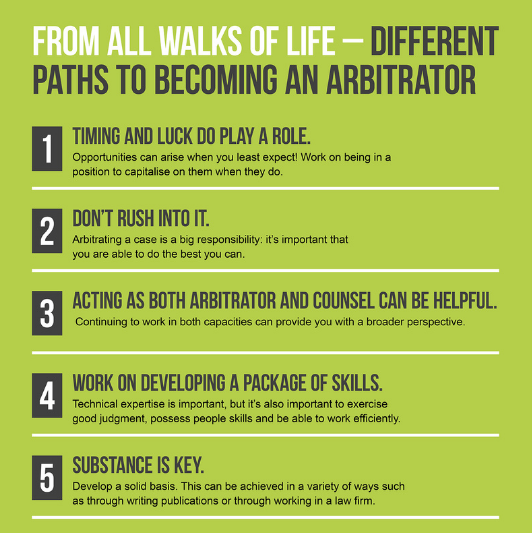
Lizzie, thanks so much for joining me today for this interview. I am delighted that you will share your thoughts on “Raising your profile and developing your career – lessons learned (and learning) during the pandemic”. How important is visibility? How does profile-raising relate to career development?
Being visible means to be seen. In international arbitration, that audience could be your peers (both inside and outside your organisation), potential clients, arbitrators and others. Visibility is important depending on what your goal is and what stage of your career you are at. For example, being visible among your peers allows you to get (and to promote others for) speaking opportunities or to get nominated to professional legal directories. For those more senior, visibility may be important to get nominated as arbitrators.
And how can you be visible in a digital world?
You can be digitally visible in numerous ways, including:
- participating in young arbitral / dispute resolution groups and collaborating with others online;
- publishing (e.g., LinkedIn posts (your own and engaging with others’ posts), blog posts, articles, newsletters etc.);
- spearheading your own initiatives (e.g., a podcast, Youtube interview series, organising online events);
and more.
Can you talk more about the online and offline elements of being visible?
The two methods are complementary. Before the pandemic, I found there was more emphasis on offline visibility, especially speaking at and attending events in person and meeting others in the same field in person. During the pandemic, we’ve relied a lot more on online platforms to host events and social media to share content. But both are important. What’s changed now is also that it’s far more common to suggest a virtual catch-up, even with someone you don’t know, whereas previously I found it was more common to connect with new people (only) if you were in the same place.
What are the major challenges when trying to raise your profile online?
Some of the challenges include:
- Using social media effectively. I credit Amanda Lee (Mandy), whom I’m lucky to serve on the ArbitralWomen Board with, for teaching me social media hacks. Mandy runs ArbitralWomen’s various communications channels and I’ve learnt a lot from her about writing effective posts and using tools such as hashtags, images and other ways to capture attention. There are many different social media platforms, but at the very least, I think using LinkedIn fluently is very important because that’s a key source of content for those in our field.
- Producing relevant content. Time is a premium, so make your content relevant and interesting. For example, I started an interview series interviewing in-house counsel about ADR techniques. While interviews with in-house counsel do exist, (as far as I’m aware) there didn’t previously exist a dedicated interview series sharing in-house counsel’s perspectives on ADR (especially international arbitration) and career advice.
- Capturing attention. Make it easy to read your content. For example, I wasn’t sure about using emojis in my LinkedIn posts initially but I now see them as a useful way to make your posts stand-out, if used effectively. Making eye-catching images to go with your posts is also a good idea (try Canva!).
You are involved in numerous initiatives, including sitting as a Board member of ArbitralWomen since 2020. In this capacity, you serve as part of the social media team. What does this role involve?
I am responsible for updating our LinkedIn and Twitter feeds for ArbitralWomen and also managing the Young ArbitralWomen Practitioners (YAWP) LinkedIn feed. Together with
Rebeca Mosquera and Mandy Lee, we publish events and news about our members. We want to highlight the wonderful work that our members are doing, including events, promotions and other initiatives.
I also design our social media campaigns for our flagship mentorship programme. We tend to get more mentee applications than mentors, so getting enough mentors is often a challenge–so our campaign has been focused on recruiting mentors.
Make it easy to read your content
Being responsible for social media: do you have any tricks you can share on how to improve social media skills?
For those who really want to improve how they use social media, I would also recommend learning about the algorithms of the social media platforms they use. For example, there are certain “hacks” that you can use to make your posts more visible. There are also people that you can follow on various social media platforms, who share tips on how to use social media effectively. You can also use data analytics to understand who is viewing your posts and which posts are getting the most attention, so that you can fine-tune your technique.
You started several initiatives during the pandemic, such as the CPR Y-ADR Corporate Counsel Interview Series, in which you interviewed in-house counsel from different companies around the world. Can you tell us more about this initiative? How did you start?
I wanted to bring out users’ perspectives on various aspects of the dispute resolution process. I felt this was important for my own learning, given that my role as external counsel is to help our clients to prevent or resolve their conflicts. I also wanted to understand from the client’s perspective what it means to “think commercially” and what their expectations of young lawyers are.
I also wanted to share career advice from in-house counsel. Based on the conversations I’ve had with in-house counsel and private practitioners, it can be challenging to find in-house counsel roles that focus specifically on disputes or where disputes work as part of the role. I wanted to get advice from in-house counsel about the factors those wishing to transition in-house should consider and where to find relevant opportunities.
Was there someone or an organisation in particular that supported your work on this series?
I was fortunate to have the support of the International Institute for Conflict Prevention and Resolution, which is a New York-based think tank on ADR. I sit as a member of our Young Leaders in Alternative Dispute Resolution Steering Committee (Y-ADR), which aims to educate the next generation of young leaders in the ADR field on the full spectrum of dispute resolution and prevention mechanisms.
As part of the CPR Y-ADR interview series, I have had interesting conversations with in-house counsel and ombuds from different companies/institutions around the world including General Motors, General Dynamics, Bechtel, Pfizer, Carlsberg Asia, Baker Hughes, Airbus, Nestlé, the University of Washington and the UK Financial Ombuds Service. (You can view the interviews here.)
I’ve gained so many interesting insights from these conversations – insights which I hope will be useful to young practitioners. One important piece of advice that has frequently come up is the importance of understanding the client and its business purpose. For example, young practitioners should read about their client’s general business (e.g., annual reports and ESG (environmental, social and corporate governance) reports), consider a client secondment and should feel confident about reaching out to the client – even just for a (virtual) coffee.
You also initiated ArbitralWomen Connect, which was nominated for a Global Arbitration Review Diversity Award in 2021. Can you tell us more about that?
At the beginning of the pandemic, I noticed that what was missing from webinars, compared with in-person events, was the networking aspect. Especially the opportunity to get to know people on a one-on-one basis. I wanted to change this, so pitched the idea of ArbitralWomen Connect to ArbitralWomen. The idea was to match ArbitralWomen members on a one-on-one-basis for a virtual coffee. The goal was to help our members build meaningful connections with others in the same field and help build solidarity in the international arbitration community during an isolating time.
In May 2020, we ran the first pilot programme, with success. We matched 11 pairs (22 participants), with representatives from law firms, barristers’ chambers, arbitral institutions, international organisations, court/tribunals, government and academia. Participants with a range of experience, from 0 to 10+ years’ experience joined. We got really positive feedback from participants, who appreciated the chance to meet someone new and have an interesting conversation.
We ran an additional cycle in 2020, and have run two cycles in 2021 already, with a view to running more later in the year. Interest in the programme has grown. For example, in our latest cycle, in June 2021, we had 30 participants (15 matched pairs) covering 9 jurisdictions; 5 different types of institutions/firms/companies; and with international dispute resolution experience from 0-3 years through to 10+ years.
I’ve participated in the programme myself and made some wonderful connections I wouldn’t otherwise have had the chance to make!
You also joined the Equal Representation in Arbitration Pledge’s (ERA Pledge) Young Practitioners Subcommittee (YPSC) during the pandemic. Can you tell us more about the YPSC, as well as the “Push for Parity” webinar series that you helped to initiate?
The ERA Pledge is an initiative to improve the profile and visibility of women and to help female arbitrators secure more arbitral appointments. In just four years of existence, more than 4,000 organisations and individuals have joined the Pledge and committed to its objectives. The YPSC pursues these objectives for the next generation. I was delighted to be invited to join the YPSC as one of around 30 members from all around the world.
A subgroup of the YPSC formed a task force focused on offering skills-building programmes for emerging arbitrators. One of our first ideas was to present a webinar series focused on launching your arbitrator career. Our online series aimed to offer honest conversation, concrete advice and answers to people’s hardest questions about becoming an arbitrator.
What was missing from webinars […] was the networking aspect
What was the content of the online series?
There were a series of four webinars and I was involved in organising the first one, inviting representatives from different arbitral institutions to offer their tips and advice for becoming an arbitrator. This seemed like a natural place to start given the ICCA Task Force on Gender Diversity’s July 2020 report found that the recent increase in gender diverse appointments is in great part thanks to arbitral institutions’ efforts to appoint more women. We hope that this series has been helpful to those, especially women, starting their arbitrator careers!
Readers might be interested in the tips that were shared during the webinar series in the below infographic (prepared by the fantastic Tope Adeyemi).
Another YPSC initiative you’ve spearheaded is the collaboration with Ernst and Young to run damages training for emerging arbitrators (together with ArbitralWomen, the Rising Arbitrators Initiative, and Racial Equality for Arbitration Lawyers). Can you tell us more about the reasons for that new initiative and what it involves?
In my experience as counsel, damages quantification can be one of the most technically challenging aspects of a matter. But perhaps it is even more difficult for an arbitrator – even if opposing parties agree on a damages methodology, they may disagree on certain assumptions that affect important inputs in a damages model. What should an arbitrator do then? Is it appropriate to select the more convincing parts of one expert’s calculations and drop them into the other expert’s model?
I approached Ernst and Young to develop a damages training programme for emerging arbitrators who may have to grapple with these issues. They proposed doing a series of interactive workshops online. We ran the first series of workshops in 2020 and again in 2021. These focused on different valuation methods and which methods may be more appropriate in certain contexts. The workshops received great feedback from participants all around the world.
I am really excited about the second series in the damages training programme, which will focus on the impact of uncertainties caused by the COVID-19 pandemic on damages quantification. These issues are likely to be very relevant in the international arbitration context, as tribunals will have to determine issues relating to loss of profit assessments bridging pre-pandemic and pandemic periods.
Any do’s and don’ts when starting an initiative?
Based on my experience, here’s my advice for starting an initiative:
- Keep it simple. Make it easy to carry out and execute youridea. If your idea involves other people, make it easy for them to be involved.
- Have a clear purpose. What are you trying to achieve through your initiative? How is your initiative different from other
initiatives? - Launch as part of an established organisation (if it makes sense). You already have an audience if you are part of an organisation with a membership. The organisation may also be able to offer other support, including promotional or technical support. You will also be able to work with others to carry out the project. Of course, it may sometimes make sense to fly solo.
- Leverage your networks. Who among your friends and networks can participate in your initiative? Are there organisations that can support and promote your initiative, or collaborate with you?
What is your take on initiatives in the near future: will the initiatives disappear when we are going “back to normal” or will the initiatives survive?
I think (and hope) that online initiatives begun during the pandemic will continue. These online initiatives have brought about important benefits, including bringing people together from all around the world (improving geographic diversity) and making events much more accessible (both from a time and cost perspective). For my part, I’ve really appreciated using video-conferencing by default because it allows you to see the other person, as opposed to just hearing their voice. I’m also really excited by the use of new social media platforms to gather together and share information, including, for example, Clubhouse.
There are too many wonderful online initiatives to name, but one in particular I’d like to mention is the Mute-Off Thursdays initiative. During the pandemic, this initiative has brought together women in the ADR field for half an hour every week to share knowledge and to build connections. It very deservedly won the GAR Award for Diversity 2021. Kudos too, to Young Mute-Off Thursdays, the sister initiative.
It’s difficult to know right now what the appetite will be for entirely online events, when life truly returns “to normal” so to speak. I imagine that hybrid events may become more common, especially if there continue to be travel restrictions and quarantine requirements for some time yet. One idea I’ve heard about recently is having local watch parties, where a group of people in the same place are watching together (online) an event happening in another place.
What kind of new skills did you learn during and maybe because of the pandemic?
One skill that I’ve learnt during the pandemic, which has surprised me, is becoming more comfortable speaking in front of a camera. Now that I have posted a few interviews, I speak much more naturally in front of a camera and can smile at the same time too!
Another skill I’ve learnt is being more comfortable about reaching out to people I don’t know and connecting. For example, I met one of the interviewees for my Corporate Counsel Interview Series on LinkedIn. I connected with her because she had “liked” a LinkedIn post featuring one of my previous interviews. In many ways, the online space has allowed me to grow not only my professional networks, but also my friendship circles.
One of your key interests is oral advocacy. During the pandemic, lawyers have had to develop new oral advocacy skills. Can you share your do’s and don’ts with us for an effective virtual presence?
I learnt some fantastic tips on this topic through participating (and being a joint winner in) the Delos Dispute Resolution’s Remote Online Advocacy Programme and attending Dr Ula Cartwright-Finch’s (of Cortex Capital) YPSC-sponsored training on “Virtual Advocacy: The Female Factor”. My top tips are:
- Get proper audio-visual equipment. It is worth investing in a good camera, microphone and halo light (to help your skin look more natural).
- Practise speaking in front of the camera: Make sure that you’re looking directly at the camera. Position yourself so that the screen frames your head and shoulders.
- Have an appropriate background. Whatever background you have, whether it is a virtual background or not, make sure that it isn’t distracting.
- Check that you can be heard (or not!): Make sure your mute button is only on when you want it to be.
What are your tips to those who want to start a career in international arbitration?
If you already know that you want to have a career in international arbitration, here are some tips I can share about breaking into the field:
- Get involved in a mentoring programme. Having a mentor who is in the field you want to enter can be an incredible resource. They can give you personalised advice relevant to your background and experience, or can put you in touch with people who can give you a hand. Several international arbitration organisations offer mentoring programmes, including ArbitralWomen, Young ICCA, ITALaw, and the Moot Alumni Association – to name a few.
- Get relevant or transferable experience, and grow your technical skills. There are many different pathways leading to a career in international arbitration. How you can get relevant experience may depend on where you first get qualified. For me, my first arbitration role was as an international arbitration intern at Herbert Smith Freehills. Apart from law firm internships, there are also opportunities to intern at arbitral institutions, international courts and tribunals and related international law organisations. A great resource is the CareersinArbitration LinkedIn page. It is also worth looking at roles where you can get transferable skills, for example, in litigation.
- Contribute to an organisation. There are many initiatives involving very junior practitioners or those looking to break into the international arbitration field. Numerous jurisdictions, including London and Paris (but also many others), have “baby” or “very young” organisations. My ArbitralWomen mentee also told me about International Arbitration Juniors.
About the Interviewer

Svenja is an attorney in Germany. She studied law at the University of Kiel and holds an LL.M. degree from Columbia Law School. Her arbitration practice concentrates on arbitration and complex commercial litigation with a particular focus on multi-jurisdictional legal actions with an emphasis on commercial questions as well as M&A and Private Equity transactions. The cases are usually subject to many different systems of law and under several institutional rules, in particular under the arbitration rules of the DIS and ICC.
She regularly speaks on panels and webinars and publishes articles in the field of international arbitration. Her passion for the changes and challenges digitalization and digital transformation mean for the legal industry led her to start the initiative “Digital Coffee Break in Arbitration”.



